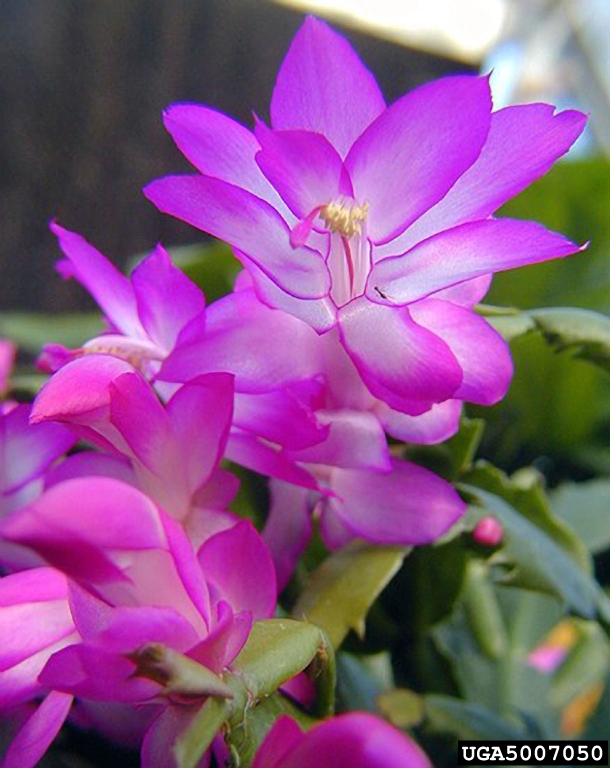 Christmas Cactus - December 17, 2014 Jeff Schalau, Agent, Agriculture & Natural Resources University of Arizona Cooperative Extension, Yavapai County Christmas cactus is a popular, fall- and winter-flowering houseplant. These plants are native to Brazil and hybrids are available in a wide variety of colors including red, rose, purple, lavender, peach, orange, cream, and white. In the wild, these species grow as epiphytes (like orchids and bromeliads) on the exterior of tree branches and rock surfaces in shady, humid rain forests. Like many cacti, these plants lack true leaves and conduct photosynthesis in their green stems which are similar, but less spiny than pads of prickly pear or joints of cholla. Plant breeders and taxonomists have broadly grouped these cactus hybrids into two groups: Truncata and Buckleyi. All of these are in the genus Schlumbergera. The Truncata group are most easily recognized by pointed/toothed stem segments; flowers held more or less horizontally with the upper and lower sides are not symmetrical (zygomorphic); and pollen which is yellow. They generally flower earlier than members of the Buckleyi Group and although common names are not used consistently, you may have heard them called Thanksgiving Cactus, Crab Cactus or Claw Cactus. The Buckleyi group has stem segments with rounded, more symmetrical teeth; more or less symmetrical flowers which hang downward; and pollen which is pink. They generally flower later than members of the Truncata Group and are more likely to be called Christmas Cactus. Easter cacti are related to Schlumbergera but are in the genus Hatiora. While the stem segments are somewhat similar to the Buckleyi group described above, the flowers are a deeper scarlet and have stamens that are arranged uniformly. The Easter cacti are from a higher elevation and considered a little more difficult to grow. If you are not sure which species/group you might have, look at the resources included below. These “holiday” cacti are actually quite easy to care for once you understand the basics. When not in flower, grow the plant as you would any houseplant. They can be kept in a shady location outdoors during the summer, but must be moved indoors before temperatures drop below 45 degrees F. Soil should be well drained. Fertilize monthly between April and October with a complete houseplant fertilizer. Prune plants in June to encourage branching which encourages more flowers. Just remove a few sections of each stem with your fingers or a sharp knife. These can be rooted to create additional plants (see below). Some references indicate these cacti respond positively to being kept somewhat pot bound. Repotting is necessary only about once every three years and is best done in the spring. The potting medium must be well-drained with good aeration, as these epiphytic cacti do not grow well in heavy, wet potting mixes. A good mix may contain 60-80% potting soil with 40-20% added perlite. These species bloom when nights are at least 15 hours long and days are accordingly short. Holiday cacti will also flower if exposed to prolonged cool temperatures between 50-55°F. No flowers will form at night temperatures above 70 degrees. When plants begin to flower, they should be kept in bright, indirect light. Too much light can cause the flower color to fade or the heat my cause the flower buds to drop. Day temperatures of 70°F and evening temperatures of 60-65°F are considered ideal. Holiday cacti are easy to propagate by cuttings. During the June pruning, save stems with 3 to 5 segments and allow the cut ends of the sections to callus by placing them in a dry, shady location for a few days. Using the mix described above, place three cuttings at approximately one inch deep into the potting soil of a 4-inch container. Water the soil well, and cover the plants and rooting container with a clear plastic bag (thin grocer produce bags work well). Secure the bag with a rubber band around the container. The plastic bag will act as a miniature greenhouse to keep the relative humidity at 100% to enhance rooting. Place the container in bright, indirect light until roots have formed in three to eight weeks. Then, remove the plastic bag and share them with friends and family. Follow the Backyard Gardener on Twitter – use the link on the BYG website. If you have other gardening questions, call the Master Gardener help line in the Camp Verde office at 928-554-8999 Ext. 3 or e-mail us at verdevalleymg@gmail.com and be sure to include your name, address and phone number. Find past Backyard Gardener columns or provide feedback at the Backyard Gardener web site: http://cals.arizona.edu/yavapai/anr/hort/byg/. Additional Resources Christmas Cactus Care University of Illinois Extension web.extension.illinois.edu/cfiv/homeowners/011110.html Thanksgiving & Christmas Cacti Clemson Cooperative Extension www.clemson.edu/extension/hgic/plants/indoor/flowering/hgic1554.html Schlumbergera Wikipedia en.wikipedia.org/wiki/Schlumbergera Hatiora gaertneri Wikipedia en.wikipedia.org/wiki/Hatiora_gaertneri |